Step-by-step instructions on how to prune currants in the spring to have a good harvest
Garden currants are represented by 2 species - black (Ribes nigrum) and red (Ribes rubrum), which, with proper care, are capable of stably bearing fruit for 15-20 years. In addition to the main measures for the care of berry bushes (watering, fertilizing, loosening and removing weeds), annual pruning is important to increase yields. The biological characteristics of the growth of branches are such that, if this is not done, the plantings thicken, the berries become smaller, and the yield decreases.
The content of the article
Why cut currants in the spring
After the snow melts, all nature awakens. The shrubs are budding in preparation for the new growing season. It is important for a gardener to assess the state of plantings after winter for diseases and freezing. Spring pruning of currants is sanitary: all dry, diseased and frozen branches are removed.
If the procedure was not carried out in the fall, a forming one is added to the sanitary pruning (the bush is thinned out, its crown is given the correct shape).
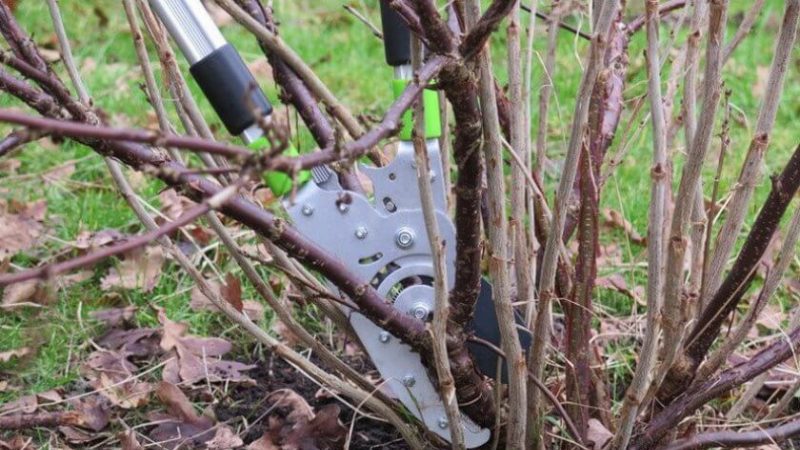
Is it obligatory
Reorganization of the crown of the bush is a necessary measure. If you leave dry or frostbitten branches on the bush, pathogens of fungal or bacterial infections will settle on them.
Reference. Diseased branches must be removed upon first detection, regardless of the season.
Advantages and Disadvantages of Spring Pruning
Without crown formation, the shrub will bear fruit for about 5 years. In the future, its yield decreases. Spring pruning benefits:
- frostbite is not terrible in places of cuts;
- it is easier to see shoots that are not capable of fruiting;
- it is easier to evaluate how the currants overwintered;
- timely removal of diseased and pest-affected branches reduces the risk of damage to the entire bush;
- partial shortening of shoots stimulates the active growth of dormant buds;
- regulation of the number of branches in the crown of the bush provides uniform illumination of the entire bush, which increases its productivity.
Spring pruning has no significant drawbacks. If you skip the fall haircut and shift everything spring events, this will not bring the expected result, but will only slightly improve the situation.
Cardinal removal of a large number of branches (more than 50% of all currants) can adversely affect the ripening of berries. A plant preparing to grow and bloom will have to spend all its energy on recovery.
Timing of spring pruning

The timing of spring pruning is chosen based on weather conditions - the time of snow melting, soil warming and bud filling... It is important to carry out the procedure before bud break and sap begins to flow. It is advisable that the night temperature does not drop below -5 ° C.
In central Russia, this is mid - end of March. If spring is abnormally warm, pruning dates are shifted to mid-February.
Types of procedure
Depending on the goal pursued, pruning is carried out to improve the health of the bush and increase its yield or rejuvenate old plantations.
Formative
It is carried out annually in order to give a beautiful shape to the currants and uniform illumination of all shoots inside the crown. If the culture is grown from a cuttings, they adhere to a certain scheme:
- After planting, the shoot is pinched over 4 buds. 4-8 new branches will grow from it.
- After a year, pinch all branches to 1/3 of their length.
- For 2 years of life, all new branches of the current year and competing shoots of the last year are removed.
- At 3 years old, young branches are again pinched by 1/3.
Having carried out such a consistent pruning, by the 4th year of life we will get a neat bush.
Anti-aging
Carried out in old plantings. This procedure requires from the gardener certain knowledge about the biological characteristics of currant growth. The full cycle of shrub formation is 5 to 8 years. The most prolific shoots of a plant are branches of 1-3 years of age. Other branches bear little fruit and take away nutrients and soil moisture from the currants. They are prone to attack by pests and diseases. Therefore, when forming a crown, it is important to remove everything that is older than 4 years. The remaining branches are shortened by 1/4 of their length.
Attention! For currants growing on the site for more than 10 years, a "stump" haircut is carried out. Absolutely all branches are cut off at the very base, leaving 3-5 cm above the ground. After that, it is useful to water the currants with hot (+ 60 ... + 70 ° C) water to stimulate bud growth and protect against pests.
How to properly prune currants in spring for a good harvest
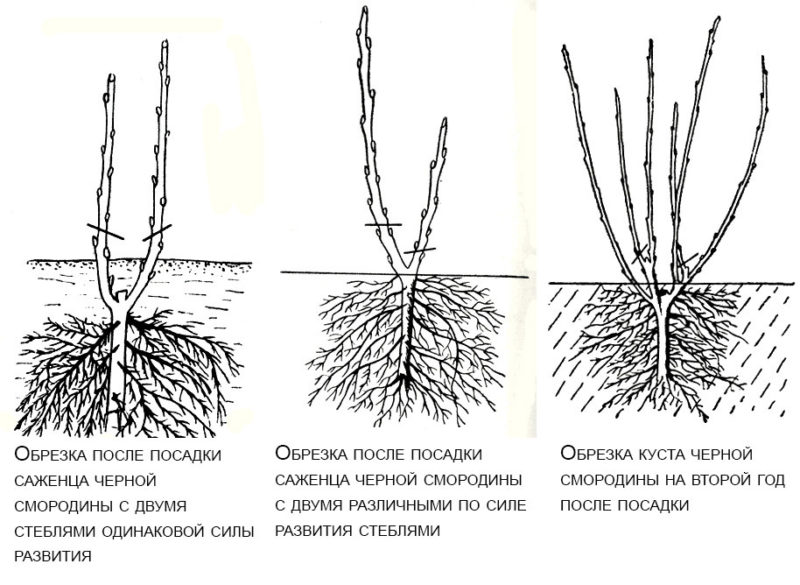
Knowing the biological characteristics of various types of currants, the gardener will not make mistakes when pruning a berry plantation.
Required materials and tools
To make the operation for cutting currants easy, prepare the inventory:
- pruning shears shortens thin and medium-diameter branches;
- the lopper is used in hard-to-reach places;
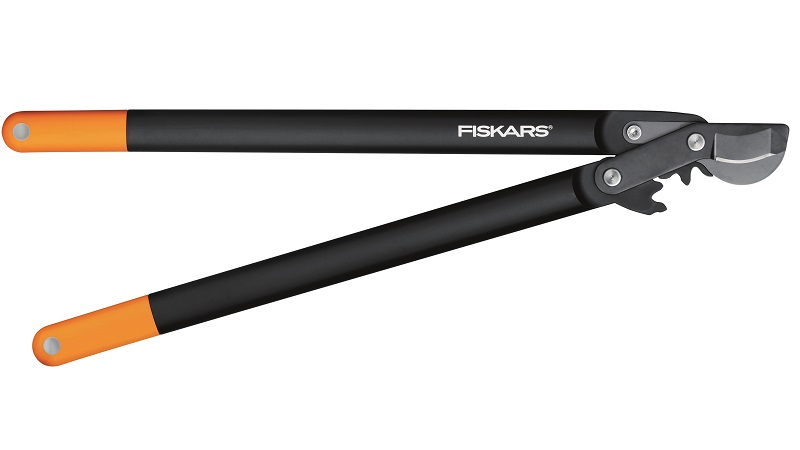
- the hedgecutter allows you to quickly, in several movements, give the bushes the desired shape (ball, hedges of a certain height);

- A hacksaw is needed to cut old and fattening shoots at the base of the plant.
After cutting, the places of cuts of thick branches are smeared with garden pitch.
Important! The tools used must be sharpened.
Step-by-step instruction

For bushes 2-4 years old, the following technology is used:
- All large shoots at the very root are sawed off with a hacksaw.
- All diseased, dry and frost-damaged stems are completely removed with pruning shears.
- Shorten all remaining stems by 1/3 of the height.
In order for the currants to recover faster after cutting, the plantings are sprayed with Epin's solution (1 ampoule per 5 liters of water). The drug will help plants recover faster from the stress experienced and quickly dissolve flower buds.
Nuances of cutting black currant
Each type of currant has its own physiological differences in the growth and formation of a bush. Black currant aging faster than red - already at 5 years of age. This means that all shoots over 5 years old must be cut out. In addition, the berries are formed on the branches along their entire length.
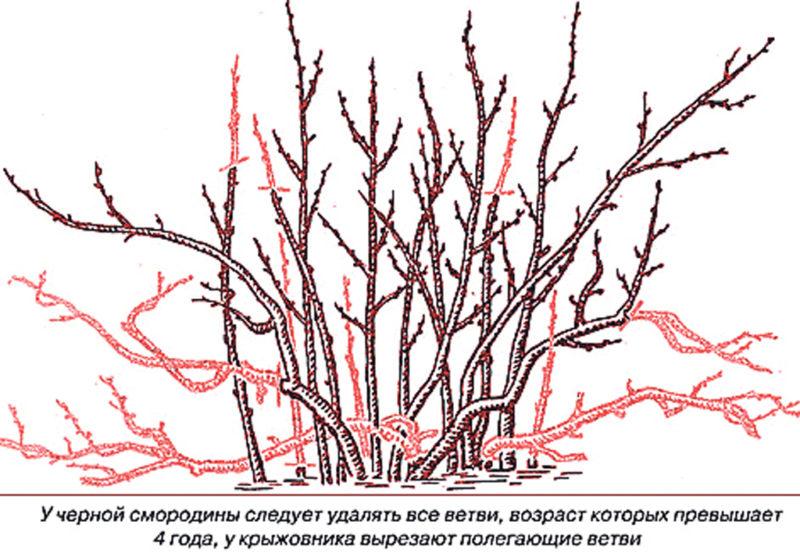
Red
In red currant, plantings are considered 7-8 years old. This species bears fruit at the tops of the shoots. The berries are formed on shortened branches called fruit. Beginners, pruning all types of currants in the same way, deprive themselves of the harvest. Therefore, at the red branch, 1/3 or 1/4 of the length is shortened only in autumn.
White
White currant is a kind of red with transparent berries of a beautiful honey color and sweet taste. Unlike red, its fruits are almost acid-free. Cut in the same way as red currants.
Features of pruning seedlings and old bushes
For seedlings 1 and 2 years old, spring pruning measures should be aimed at stimulating the growth of side branches. All young growth is shortened by 1/3.
Rejuvenating pruning is useful for those who do not want to part with their favorite bushes and plant new ones in their place. It is usually carried out at the 7-9 year of life of the currant. All shoots are cut off completely, leaving 5-8 cm above the ground.
Post-procedure care
Any pruning weakens the plant a little. At this time, currants become vulnerable to pests and diseases. To prevent this from happening, immediately after the procedure, the bush is treated with copper-containing preparations (copper sulfate or Bordeaux liquid). They protect berries from most fungal diseases and simultaneously serve as a mineral top dressing.
When the soil around the bushes warms up well, a bucket of humus, potassium salt (50-60 g) and superphosphate (60 g) are added to the trunk circles (at each individual bush or around a group planting). Such feeding contributes to the active growth of new shoots. The bushes are watered, and then the soil is loosened. For awakened plants, the usual agrotechnical measures are resumed: regular watering with loosening, systematic feeding, treatment against pests and diseases.
Tips and tricks from experienced gardeners
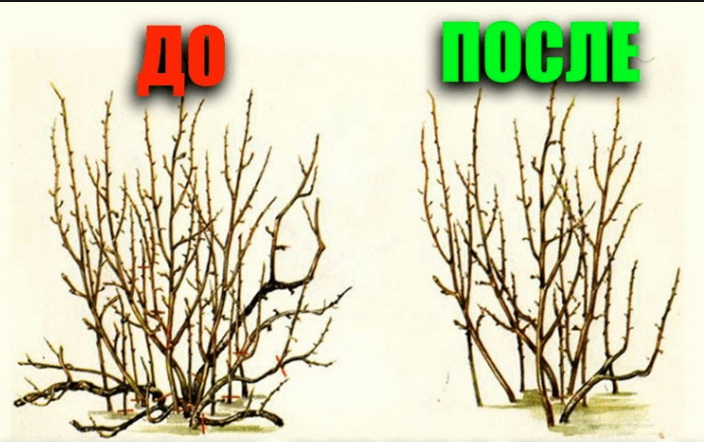
Expert advice will help you avoid many mistakes.
Boris Alexandrovich, Kharkov: “I offer an effortless way of cutting currants. In a perennial bush, place 2 mutually perpendicular planks and leave them there. The sticks form 4 sectors and make it easier to determine the trimming boundaries. In the first year, cut out the contents of the first sector. In the second year, remove the underdeveloped shoots of the first sector and everything in the second. Then repeat the process in a circle. "
Anna, Vladimir region: “Our red currant is growing, planted back in the 50s. my father. In one place, the yield is excellent. True, this cannot be called a bush. Powerful branches grow at a considerable distance from each other. From time to time I rejuvenate, I follow the distance between the branches, because I have to climb inside the bush to harvest. Therefore, 15 years of age is not the limit for red currants. "
Conclusion
Spring pruning is aimed more at rehabilitating the crown from old, sick and dried branchesto make room in the sun for young growth. In red and white currants, unlike black, shoots of 1-3 years in the spring are not shortened. A phased annual procedure will prolong the life of the plants and allow you to get a bountiful harvest of berries.